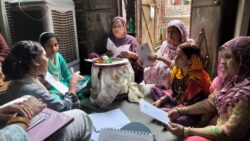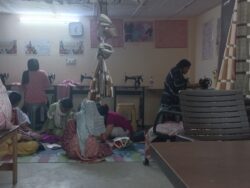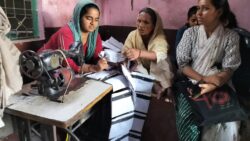The garment industry in India: A paradox of progress and exploitation (Part 2 of 2)
Off Paper: The Hidden Cost of Home-based Workers
By: Aastha Jain , member of Fashion Revolution India
 No Policies, No Records—42 million home-based workers remain systematically invisible, with approximately 19% engaged in apparel production. As a policy researcher with the Fashion Transparency Index Working Group between September 2024 and December 2024, I met several women stitching buttons and embroidering and overturning socks in Delhi’s dense colonies, revealing the mechanisms through which capitalist structures perpetuate exploitation, transforming homes into sites of economic negotiation.
No Policies, No Records—42 million home-based workers remain systematically invisible, with approximately 19% engaged in apparel production. As a policy researcher with the Fashion Transparency Index Working Group between September 2024 and December 2024, I met several women stitching buttons and embroidering and overturning socks in Delhi’s dense colonies, revealing the mechanisms through which capitalist structures perpetuate exploitation, transforming homes into sites of economic negotiation.
The informal sector has three archetypes: contractors, piece-rate workers, and self-employed workers. Their labour encompasses completing semi-finished apparel and accessories like bags, shoes, cushion covers, and bangles, assembling bindi packets, attaching buttons, applying trims, packaging, labeling, embroidery, and crochet.
 Fixed contractors connected to factories function as intermediaries who distribute work daily or weekly in different neighborhoods. Factories dictate compensation for the contractors. The contractors extract a 40-50% margin before redistributing wages. Piece rates demonstrate huge variability, fluctuating based on geographical location, distance from factories, labour demand, and skills scarcity—ranging from INR 1 ($0.012) to INR 70 ($0.83) per piece. The COVID-19 pandemic exacerbated existing vulnerabilities. Unlike other sectors experiencing recovery post-pandemic, this trade witnessed a wage decline. Contractors, who also tend to be migrant workers, often run away with the due amount. Those who stay nearby or in the same neighborhood as workers show cooperation and timely payment.
Fixed contractors connected to factories function as intermediaries who distribute work daily or weekly in different neighborhoods. Factories dictate compensation for the contractors. The contractors extract a 40-50% margin before redistributing wages. Piece rates demonstrate huge variability, fluctuating based on geographical location, distance from factories, labour demand, and skills scarcity—ranging from INR 1 ($0.012) to INR 70 ($0.83) per piece. The COVID-19 pandemic exacerbated existing vulnerabilities. Unlike other sectors experiencing recovery post-pandemic, this trade witnessed a wage decline. Contractors, who also tend to be migrant workers, often run away with the due amount. Those who stay nearby or in the same neighborhood as workers show cooperation and timely payment.
A shared space for home and work exposes profound gender-based contradictions. Women, responsible for domestic labour, are compelled to negotiate complex frameworks—first fulfilling family responsibilities, then pursuing work in the remaining time. Women decide whether they can accommodate more labour or not as per their domestic schedule. Many women are not allowed to move outside, rendering home-based work as a survival strategy. Work remains fundamentally precarious: no monthly guarantees, with labour oscillating between hectic periods and prolonged intervals of scarcity. The irregularity breeds systemic mistrust and hopelessness, compelling some to abandon this labour mode while others persist as a final economic recourse.
 To meet their basic needs, workers try to maximise work, generating low piece-rate wages. Such compensation structures incentivize maximum labour extraction. Families, including children who spend substantial amounts of time with mothers, become integrated into production processes. The fundamental contradiction emerges: how can corporations proclaim freedom from forced or child labour when entire communities are economically coerced into such labour arrangements?
To meet their basic needs, workers try to maximise work, generating low piece-rate wages. Such compensation structures incentivize maximum labour extraction. Families, including children who spend substantial amounts of time with mothers, become integrated into production processes. The fundamental contradiction emerges: how can corporations proclaim freedom from forced or child labour when entire communities are economically coerced into such labour arrangements?
In Delhi, workers inhabit densely populated neighborhoods characterized by open sewage systems, intermittent electricity supply, water scarcity, and inadequate ventilation. Typical living rooms(a 10 x 10 feet space)egregiously contradict International Labour Organization (ILO) conventions mandating workspace requirements. Workers absorb additional economic burdens, including electricity costs, healthcare expenses, and workspace rental, which remain strategically unaccounted for in supply chain calculations.
“Bindi sticking impacts eyesight, back pain, and exposure to chemicals severely. Another such hazard is from clothes made with chemical dyes. During extreme heat in summer, dyes stick to hands causing skin infections. No provision of safety gears, social security schemes, healthcare provisions worsen the worker’s conditions.” – Subadhra Pandey, Representative SEWA in Delhi
 Unionization of informal workers confronts multifaceted obstacles: absence of direct employer contact, lack of governmental protective mechanisms, and the invisibility of home-based labour. Brand identification by workers and the union is impossible within this fragmented production ecosystem. Merely 0.25% of workers comprehend their position within broader supply chains, mentions Subadhra. The proliferation of counterfeit products further obscures potential accountability mechanisms.
Unionization of informal workers confronts multifaceted obstacles: absence of direct employer contact, lack of governmental protective mechanisms, and the invisibility of home-based labour. Brand identification by workers and the union is impossible within this fragmented production ecosystem. Merely 0.25% of workers comprehend their position within broader supply chains, mentions Subadhra. The proliferation of counterfeit products further obscures potential accountability mechanisms.
SEWA is a union of 2.9 million informal workers. SEWA in Delhi serves 70,000 workers out of which 7,000 work in the garment industry as home-based workers. Along with other South Asian organisations, the union has developed a transparency tool called Wage Card to document monthly work and negotiate for fair wages. This tool records transactional details, work performed, payments due, and brand associations.
 The fundamental struggle demands systemic recognition. Unions articulate comprehensive demands: joint employer responsibility, profit redistribution, social security provisions, regular work, minimum wage guarantees, and most importantly ratification of international labour conventions- C177.
The fundamental struggle demands systemic recognition. Unions articulate comprehensive demands: joint employer responsibility, profit redistribution, social security provisions, regular work, minimum wage guarantees, and most importantly ratification of international labour conventions- C177.
The invisibility of home-based workers reinforces profound epistemic violence—where labour is essential yet systematically marginalized. Most workers do not even acknowledge themselves as workers but as homemakers, wives, or mothers. Their work remains unacknowledged by governments, employers, and manufacturers alike. The hidden costs—including electricity, tools, healthcare, family labor, and unpaid wages—create a perception of cheap production, enabling brands to increase profits by transferring economic burdens to the working class of producing nations.
–
The article is written by Aastha Jain, a visual designer and researcher. She is also a member of Fashion Revolution India. The insights are based on discussions with Subadhra Pandey, Representative SEWA in Delhi, and home-based workers from Delhi. For contact, reach at: aasthajn29@gmail.com








